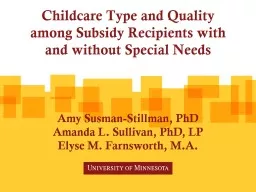

Amanda L Sullivan PhD LP Elyse M Farnsworth MA Childcare Type and Quality among Subsidy Recipients with and without Special Needs Context CCDBG Reauthorization OPRE interest in special populations ID: 636444
Download Presentation The PPT/PDF document "Amy Susman-Stillman, PhD" is the property of its rightful owner. Permission is granted to download and print the materials on this web site for personal, non-commercial use only, and to display it on your personal computer provided you do not modify the materials and that you retain all copyright notices contained in the materials. By downloading content from our website, you accept the terms of this agreement.
Slide1
Amy Susman-Stillman, PhDAmanda L. Sullivan, PhD, LPElyse M. Farnsworth, M.A.
Childcare Type and Quality among Subsidy Recipients with and without Special NeedsSlide2
Context CCDBG ReauthorizationOPRE interest in special populationsDifferences in early care and education experiences? Benefits from subsidies equally experienced?Unique considerations? Slide3
Young Children with Special NeedsSubstantial portion of young children are at-risk (Boyle, et al, 2008; Rosenberg, Zhang, & Robinson, 2005)Developmental DelaysCongenital DisordersDevelopmental DisabilitiesChronic IllnessesSlide4
Why Does Differential Use for Young Children with Special Needs Matter?Educational AttainmentMental HealthHealthRelationshipsEmployment & EarningIndependent LivingCriminal Justice InvolvementSlide5
Consequences of Early Childhood Special NeedsSlide6
Study FrameworkHigh quality ECE beneficialSubsidy use increases use of licensed & publicly-funded programs Subsidy use increases use of quality (usually centers)Subsidy density related to quality careGoal/Assumption:Current LiteratureSlide7
Unique quality considerations Structural Adult:childCaregiver knowledgePhysical environment, equipmentProcessCaregiver-child relationshipIntensity of caregiving needsHow do subsidies affect the type and quality of care that families with children with special needs select? Slide8
Research QuestionsDoes type of care for subsidy users differ by special need status?What types of care are accessed by subsidized children with special needs?What is the quality of care accessed by subsidized children with special needs?
Do subsidized children with special needs spend more time in child care than non-subsidized children with special needs? Slide9
Data Source and Analytic SampleData SourceEarly Childhood Longitudinal Study – Birth Cohort (ECLS-B)Nationally-representative dataset of children born in US in 2001Analytic Sample (9 months, 2 years, 4 years)Children eligible for subsidies ranged from 1,498,800 at 9 mo - 1,404,300 at 4 years (weighted; unweighted 4000 (9 mo) -3100 (4 years)Subsample 1: All children using subsidies (weighted N= 163,000 at 9 mo – 101,700 at 4 yrs; unweighted N = 450 at 9 mo - 300 at 4 yrsSubsample 2 : Subsidy-eligible children with special needs (weighted N= 81,500 at 9 mo - 344,350 at 4 yrs; unweighted = 450 at 9 mo – 1250 at 4 yrs Slide10
Study VariablesSlide11
Study VariablesSlide12
Ecological Predictors of Type & QualitySlide13
Does choice of care differ by special need status?Slide14
Does choice of care differ by special needs statusSlide15
What Types of Care Are Accessed by Children with Special Needs?Slide16
What Predicts Use of Home or Center-Based Care by Subsidy-Eligible Children with Special Needs? 9 months2 years4 years1 or more siblings Home Center Center Home & Center
Unmarried parents
Home &
Center
Home & Center
Maternal work status
Home & Center
Home & Center
Home &
Center
HS or less (v. > HS)
Center
No healthcare subsidies
Center
Region
Center (South)
Gender, race, home language not English,
m
aternal age, use of food subsidies non-significant
Slide17
Caregiver:Child and Hours of CareSubsidy-using children with special needs, compared to their non-subsidy-using peers with special needs:were more likely to experience caregiver:child that did not meet quality standardsused more hours of care than non-subsidy-using children with special needs (all z scores significant at p < .05)Slide18
What is the quality of care accessed by subsidized children with special needs?No consistent improvement in access to quality careSlide19
SummarySlide20
ImplicationsAttention needs to be paid to the quality of care accessed by families with children who have special needs, both on the parent/consumer end and the provider end.Family characteristics not necessarily consistent predictors of care for children with special needs.Parental underutilization of subsidy because quality is harder to access? Slide21
Thank you For more information, please contact:Amanda Sullivan, asulliv@umn.eduAmy Susman-Stillman, asusman@umn.eduVisit www.cehd.umn.edu/ceed/projects/subsidyutilization/default.html Slide22
CCBDG Allows State FlexibilitySlide23
Does choice of care differ by special need status? 9 months2 years4 yearsSubsidized special needsHome-based Center-based Home-basedCenter-basedHome-basedCenter-basedSubsidized no special needsHome-based
Center-based
Home-based
Center-based
Home-based
Center-based